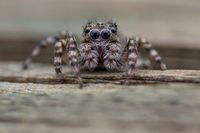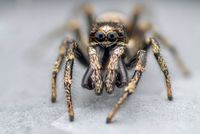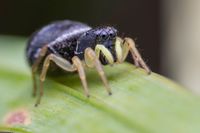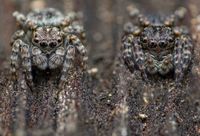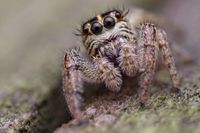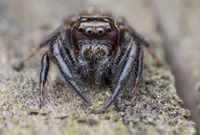Native Species
Jumping spider species native to Switzerland and wide parts of Europe.
"Attulus terebratus"
A small species with a body size of approx. 4-5 mm of which I find a small colony near Zurich that lives in old telegraph poles. A curious-looking male (first photo) and a courting pair, with the male on the left bewitching the female with his front legs. For mating, the male climbs over the female and inserts his sperm packet with the pedipalps.
"Marpissa muscosa" (Fence jumper/tree bark jumper)
A female with the typical mask and cream-colored band under the eyes. With a body length of up to 11 mm, it is one of the largest species in Europe, the males remain somewhat smaller. This species can be found on tree trunks with bark or on wooden structures such as fences or weathered sheds.
A male with its thickened pedipalps resembling boxing gloves. The sexual dimorphism of this species is clearly visible. These spiders are skilled hunters able to take down prey much larger than themselves.
"Evarcha arcuata" (Monkey spider/dark jumper)
With a body size of 5-8 mm, this species is already one of the medium-sized jumping spiders. Here too, the male shows a clear dimorphism and remains slightly smaller than the females. These small goblins find their habitat in wet meadows, often near bodies of water. The males in particular (last picture) are reminiscent of a monkey in their appearance.
"Salticus scenicus" (Zebra jumping spider/harlequin spider)
The zebra jumping spider is one of the most common species in our latitudes and can often be found near settlements on walls, often also in the house. The size is 4 - 7 mm, males (last picture) stay a bit smaller, but have almost grotesquely extended jaw claws (chelicerae), which they also use in territorial fights.
"Leptorchestes berolinensis" (Ant-mimicking jumping spider)
With its slender, approx. 5-7 mm long body and the indicated segmentation, this species is very reminiscent of an ant. The usually lifted first pair of legs with which it signals (and probably picks up pheromones) further reinforces this impression. Males (last picture with prey) can be recognized by their thickened pedipalps.
"Heliophanus sp."
At least a dozen species of this genus are represented here, which look very similar and can often only be distinguished under the microscope. The females can be recognized by their yellow pedipalps and shimmering metallic body, adult males have black pedipalps with a white stripe. The size of each species varies from tiny to small. The habitat is very variable, often grassy areas and dry meadows.
"Attulus pubescens"
A close relative of "Attulus terebratus" and very difficult to distinguish at first sight. Both species are identical in size and basic colour. Males are about 4 mm, females about 5 mm. "Attulus pubescens" has four bright spots on the hind body, "A. terebratus" has a more geometric pattern with angles and triangles.
The picture shows a male (right) and a female in a photomontage. It can be seen that the male is slightly smaller and lighter in color than the female, although the pattern and color can be quite variable. This species is somewhat of an urban species and is commonly found on fences, weathered wood, and masonry.
"Macaroeris nidicolens"
The bold looking males grow to a size of 4-6 mm, the beautiful females to 6-7 mm. This is a very inquisitive species and not very shy.
I consider the females with their typical "eyelashes" to be one of the prettiest jumping-spider to be found in Europe. I usually find them on a weathered fence were they hide in the cracks and hunt on the surface.
Originally distributed in the mediterranean region this species follows the warmer climate zones up north and can be found in the north of Germany already.
